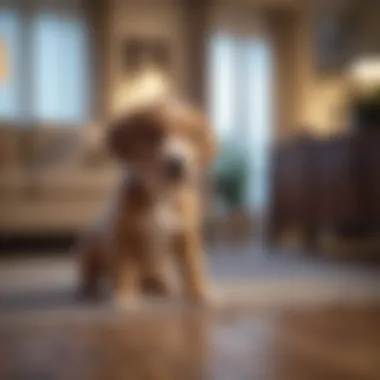Addressing Indoor Accidents in Puppies: A Dog Owner's Guide


Intro
Puppies are often seen as bundles of joy, but they can also be a source of frustration, especially when they have accidents indoors. Understanding why these incidents occur is essential for dog owners. This guide deeply explores the factors contributing to indoor accidents in puppies, including behavioral, environmental, and health-related aspects. The goal is to provide you with effective strategies for training and prevention, helping your puppy develop good habits from a young age.
Fascinating Facts About the Animal
Puppies belong to a species known for its adaptability and complex social structures. Each breed has its own unique traits that influence behavior and learning. Understanding these fascinating characteristics can enhance your approach to training and reduce indoor accidents.
Unique Characteristics
Puppies possess a remarkable degree of adaptability. Their capacity to learn and adjust to their environments depends on various factors including breed, age, and previous experiences. This adaptability can be leveraged in training, allowing owners to customize their approach based on individual dog needs.
Extraordinary Abilities
Many puppies exhibit an extraordinary sense of smell. This ability does not only serve their natural instincts but can also play a role in training. By utilizing scent-based commands, owners can create a more engaging and effective training environment. For instance, scent trails can guide puppies toward appropriate potty areas, reinforcing good habits.
Behavior and Habitat
Understanding a puppy's behavior is crucial for addressing accidents. Their natural instincts and environmental surroundings significantly influence their actions.
Natural Habitats
Puppies, like their adult counterparts, have instincts derived from their wild ancestors. They look for designated areas for elimination. Providing a suitable outdoor space can cater to these instincts, making it easier for your puppy to understand where they should go.
Social Structures
Puppies are social animals. They learn behaviors by observing their fellow canines and their owners. Positive reinforcement when they go potty outside allows them to associate good behavior with rewards. This understanding of social learning makes it vital for owners to be consistent and patient.
Recent Scientific Discoveries
Research regarding dog behavior has grown significantly, providing insights into effective training methods and understanding canine needs.
Latest Research Findings
Recent studies indicate that early socialization and consistent potty training routines can reduce indoor accidents. Dogs that are exposed to various environments and other animals from a young age tend to be more adaptable and better at understanding commands.
Breakthroughs in Animal Biology
Understanding the biology of a puppy's urinary system can shed light on their potty habits. Puppies have smaller bladders and less control than adult dogs, which explains frequent accidents. Recognizing this physical limitation helps owners adjust their expectations during training.
Epilogue
Addressing indoor accidents in puppies requires a blend of knowledge and practice. By understanding their natural behaviors, environments, and recent scientific findings, dog owners can implement more effective training strategies. Patience and consistency in this process enable puppies to develop the good habits necessary for a harmonious coexistence.
Understanding Puppy Accidents
Understanding the nature of puppy accidents is crucial for all dog owners. Puppies, like children, are learning how to navigate their environments. They are not just small versions of adult dogs; they have specific needs that contribute to behavioral patterns and possible indoor accidents. Recognizing these patterns can lead to better training and more effective measures for managing the associated issues. This section aims to delve into the nature of puppy behavior and the various factors that can lead to indoor accidents, helping pet owners take proactive steps to foster a healthier relationship with their dogs.
The Nature of Puppy Behavior
Puppies are naturally curious and energetic. They explore the world around them through their senses, which often leads to unintentional accidents indoors. During this exploration phase, they might not fully grasp the concept of where and when to relieve themselves. Understanding that accidents are part of their learning process can reduce frustration and create a more supportive environment for the puppy. Puppies also have limited bladder control, especially in their early months. The connection between behavior and potty training must be clear to prevent indoor mishaps.
Common Causes of Indoor Accidents
Several factors contribute to indoor accidents in puppies. Addressing these can create a more conducive atmosphere for learning and development.
Age and Bladder Control
The age of a puppy plays a significant role in bladder control. Young puppies, especially those under six months, have not developed sufficient control over their bladders. Their small bladders mean they need to eliminate more frequently than adult dogs. This lack of control can lead to frequent accidents as they may not hold it long enough. A key characteristic of this reality is that it requires patience from the dog owner. Recognizing this fact is beneficial for any owner, as it emphasizes the need for frequent outdoor trips to reinforce good habits.
Lack of Proper Training


Another common cause of indoor accidents is a lack of proper training. Puppies do not automatically understand where it is acceptable to relieve themselves. Without guidance, they might choose inappropriate places in the house. A well-structured training routine can help instill the correct behaviors. The main characteristic here is that consistent training helps set boundaries. This method is favored in this article as it lays the groundwork for responsible pet ownership. If training is inconsistent, it can confuse the puppy, making it harder for them to learn the desired behavior.
Health Issues
Health issues can also lead to accidents. Medical conditions such as urinary tract infections or gastrointestinal problems can cause frequent urges to relieve themselves. Puppies may have difficulty holding it due to pain or distress. Therefore, it is important to monitor any changes in behavior or elimination patterns. Health-related factors must be considered along with behavioral aspects. Recognizing any medical problems early is a critical step in addressing indoor accidents effectively, especially to eliminate potential health risks.
Understanding the nuances of puppy behavior and the factors causing indoor accidents can vastly improve the training experience for both the pet and the owner.
Identifying Health Issues
Identifying health issues is a crucial aspect for dog owners dealing with indoor accidents. Recognizing that not all accidents are just part of normal puppy behavior is essential. This section seeks to guide owners in understanding when an accident might signal something more serious. Timely identification of health issues can lead to prompt veterinary intervention. Ignoring potential problems could result in prolonged suffering for the puppy and greater challenges in house training.
Signs of Medical Problems
When evaluating a puppy that has frequent indoor accidents, dog owners should look for particular signs of medical issues. Some common indications that might suggest a puppy is experiencing health problems include:
- Persistent Diarrhea: Frequent and watery stools can indicate intestinal problems or infections.
- Frequent Urination: If a puppy seems to urinate excessively, it may point towards urinary tract infections or other health concerns.
- Straining to Urinate or Defecate: Any signs of discomfort during bathroom activities warrant immediate attention.
- Vomiting: Regular vomiting can affect hydration and overall health, indicating that something is wrong.
- Signs of Pain: If a puppy exhibits unusual behavior, such as whining or restlessness, it may be in pain.
It is important to observe pup's general behavior. A sudden change in appetite or energy level is also significant. Keep in mind that these signs should be taken seriously and discussed with a veterinarian for further evaluation.
When to Consult a Veterinarian
Knowing when to consult a veterinarian can make a significant difference in a puppy's health. If a puppy displays one or more signs mentioned earlier, consulting a veterinarian is advisable. Here are some situations that require prompt medical attention:
- Rapid onset of symptoms: If symptoms appear suddenly, it may indicate an acute issue.
- Symptoms that persist for more than 24 hours: Ongoing signs after a day often require veterinary input.
- Signs of severe pain or distress: If the puppy displays extreme discomfort or other severe symptoms, immediate care is essential.
It may also be helpful to keep a record of the puppy's symptoms, including frequency and duration of accidents. This information can assist the veterinarian in making a proper diagnosis. In any case, the owner should trust their instincts. If anything seems off, erring on the side of caution is always the better option.
Consulting your veterinarian ensures that any serious health issues can be addressed quickly, preventing further complications.
Puppy Training Basics
Training is a fundamental aspect of pet ownership, especially when it comes to puppies. It shapes their behavior, ensures safety, and fosters a healthy relationship between the puppy and the owner. A solid understanding of puppy training basics can significantly reduce indoor accidents and contribute to a smoother integration into the household environment.
There are several key elements in this area, which involve creating consistency, developing positive habits, and using techniques that promote learning in a non-threatening manner. Additionally, puppy training can instill a sense of security in the young dog, which can help to reduce anxiety and behavioral issues as they mature.
Establishing a Routine
A consistent routine is one of the backbones of effective puppy training. This structure offers clarity to the puppy and sets clear expectations regarding when and where to eliminate. Establishing specific times for feeding, play, and bathroom breaks fosters predictability.
- Feeding Schedule: Regular meals help regulate bathroom needs. Feed the puppy at the same times each day.
- Bathroom Breaks: Take your puppy outside immediately after meals and before bedtime, and regularly throughout the day.
- Playtime: Engage in play sessions to reinforce this positive interaction and serve as a reward for good behavior.
Overall, by maintaining a routine, owners facilitate better understanding and learning for their puppies.
Using Positive Reinforcement
Positive reinforcement is a powerful technique in puppy training. It involves rewarding desired behaviors instead of punishing undesirable ones. This approach encourages the puppy to repeat behaviors that lead to positive outcomes.
- Types of Rewards: Treats, praise, and affection work well as rewards. It is important to use something the puppy values.
- Behavior Recognition: Quickly acknowledge and reward a correct behavior to strengthen the association.
- Consistency is Key: Use the same commands and rewards to prevent confusion over time.
Incorporating positive reinforcement can create a more enjoyable training experience for both owner and puppy, while simultaneously promoting learning.
Crate Training as a Tool
Crate training serves multiple functions in puppy training. It creates a safe space for the puppy and, when used correctly, can become an effective tool in house-training.
- Understanding Crates: The crate should feel like a den, not a punishment. Make it inviting with bedding and toys.
- Gradual Introductions: Introduce the crate gradually. Allow the puppy to explore, and reward them for entering.
- Not a Long-term Solution: Remember that young puppies should not be confined for extended periods, as they need frequent breaks.
Crate training can help manage a puppy's safety and facilitate better habits, reducing the likelihood of indoor accidents when used properly.
Remember, consistency in training and a solid understanding of your puppy's needs can make a significant difference in their behavior development.


Creating a Supportive Environment
Creating a stable and nurturing environment is essential for puppies as they acclimate to their new home. This aspect is not only crucial for reducing accidents indoors but also supports overall development and well-being of the puppy.
Establishing a supportive space requires attention to several key details. First, proper outdoor access allows the puppy to relieve itself outside, reducing the chance of accidents indoors. Second, monitoring their food and water intake regulates their needs, which promotes better bathroom habits. Finally, assessing the living area for hazards ensures a safe place for the puppy to explore. Each element plays a role in shaping good habits and instilling a sense of security.
Designating an Outdoor Area
Designating a specific outdoor area for your puppy is a significant step. This area should be easily accessible, allowing the puppy to go out when needed without complications. Make sure it is a quiet spot, away from distractions, to encourage them to focus on their task.
A consistent outdoor area helps establish a routine. Puppies thrive on consistency, so if they learn that this area is for relieving themselves, they will start to associate being outside with the action required. Regular trips to this area, especially after eating or drinking, will help reinforce this behavior.
Monitoring Food and Water Intake
Monitoring the food and water intake is essential. Puppies who have unrestricted access to food and water may not develop a predictable bathroom schedule. Instead, it is more effective to provide set meal times and limit access to water in the evening, if necessary.
Tracking what your puppy eats can indicate their health and help identify any potential issues before they become severe. Keeping a structured feeding schedule feeds into the routine, making training easier and reducing accidents in the house.
Assessing Living Space for Hazards
Evaluating the living space for potential hazards is a necessary priority. Puppies are naturally curious and explore their environment by chewing and sniffing everything. Look around for items that could be harmful, such as cords, small objects, or toxic plants.
Creating a safe environment not only prevents physical harm but also decreases anxiety. An anxious puppy may have more accidents due to stress. By removing hazards, you provide a secure environment conducive to learning and development.
A supportive environment is a foundation for success in puppy training. It helps establish good habits while ensuring the safety and well-being of your pet.
Maintaining Consistency in Training
Consistency is a cornerstone of effective puppy training. When it comes to addressing indoor accidents, having a solid plan and sticking to it will yield positive results. Puppies thrive on routine, which instills a sense of security. Developing a standardized approach not only helps in communication between the dog and the owner but also reinforces desired behaviors.
One significant element in maintaining consistency is establishing clear expectations. This means defining what behaviors are acceptable and what are not. For instance, if a puppy is allowed to play freely in one area of the house but not another, mixed signals can lead to confusion. By setting consistent boundaries, the puppy learns what is expected.
Additionally, regularity in reinforcement plays an essential role. If a puppy successfully goes outside to relieve itself, providing immediate praise or a treat solidifies that behavior. Over time, this learning process will help the puppy understand that going outdoors is the preferred option. Consistency in rewarding positive actions, rather than punishing negative ones, promotes a healthier training environment.
Some benefits of maintaining consistency include:
- Faster Learning: Puppies that receive consistent signals tend to understand commands more quickly.
- Behavior Modification: Consistent training can change unwanted behaviors more effectively.
- Strengthened Bond: Regular interaction through training activities fosters a stronger relationship between the puppy and owner.
In summary, maintaining consistency in training not only tackles indoor accidents but also promotes a well-mannered puppy. By establishing clear routines and expectations, one sets the foundation for long-term success.
Importance of Routine
Establishing a daily routine is crucial for puppies, as it provides them with structure. A schedule that includes regular feeding, outdoor time, and play periods helps puppies learn when to expect potty breaks. When the puppy knows what to expect, they are less likely to have accidents indoors.
Here are some key aspects of establishing routine:
- Feeding Schedule: Serving meals at the same time each day helps regulate bathroom habits.
- Potty Breaks: Observing a routine to take the puppy outside, especially after meals or play, greatly reduces accidents.
- Playtime and Exercise: Providing regular play and exercise helps dogs manage their energy levels, reducing anxiety that may lead to accidents.
A structured routine minimizes confusion for the puppy, ultimately paving the way for a smoother learning experience.
Engaging Family Members
To achieve consistency in training, it is important that all family members are on the same page. Everyone should understand the established rules and routines for the puppy. Engaging family members in the training process creates a unified front, preventing mixed messages that could confuse the puppy.
Here are some strategies for engaging family members:
- Communication: Regular family meetings can help discuss training progress and any adjustments needed.
- Shared Responsibilities: Assigning specific roles in training can help everyone stay involved and responsible.
- Unified Commands: Ensure that everyone uses the same commands and signals when training the puppy.
By fostering a cooperative environment, all family members become part of the training success, contributing to stronger habits and a more well-behaved puppy. This support system is vital in reinforcing training consistency and addressing indoor accidents effectively.
Consistency in training is essential for a puppy's learning. A mixed approach causes confusion. Having all family members involved leads to better results.


Monitoring Progress
Monitoring progress is a crucial aspect in the training and acclimatization of puppies. It helps dog owners identify patterns, assess the effectiveness of various strategies, and make necessary adjustments. This ongoing evaluation not only promotes effective training but also strengthens the bond between the owner and the puppy, creating a cohesive living environment.
Keeping a Journal
One efficient method to track a puppy's progress is by keeping a journal. This journal should detail daily events, training sessions, accidents, and successes. By noting each incident, the owner can identify triggers that lead to accidents. For instance, if there are frequent mishaps after specific meals or playtimes, it is possible to adjust the feeding schedule or increase supervision during those periods.
A journal also aids in recording changes in behavior over time. As the puppy develops, noting changes in habits provides a clear picture of their evolving needs. It can be beneficial for noticing improvement in restroom habits, obedience to commands, and overall behavior.
Key elements to include in a journal:
- Date and time of training sessions.
- Frequency of indoor accidents.
- Puppy reaction to different training techniques.
- Notes on health changes or peculiar behavior.
Adjusting Strategies as Needed
Flexibility in training is essential. Puppies thrive when training methods are adjusted based on their responses. If a particular strategy is not yielding results, it is essential to reassess and tweak the approach. This might entail exploring new training techniques or revising existing routines.
For example, if positive reinforcement is not effective, introducing clicker training might engage the puppy better. Tracking progress helps owners understand which approaches resonate with their puppy. Furthermore, it can be helpful to consult with a trainer or veterinarian for insights tailored to the puppy's specific needs.
- Considerations for adjusting strategies:
- Monitor the puppy's emotional responses to training.
- Recognize if the puppy feels overwhelmed or indifferent.
- Consider age and developmental stage when introducing new methods.
- Engage family members in training for consistency.
By prioritizing monitoring and allowing room for adjustments, dog owners can create a nurturing environment that fosters growth, development, and an overall sense of well-being in their puppies.
Dealing with Setbacks
Managing a puppy is rewarding but can also present its challenges. Setbacks in training, especially regarding house accidents, are not only frustrating but can give rise to stress for both the puppy and the owner. Understanding how to handle these setbacks effectively is crucial for long-term success, helping to form a solid foundation of trust and respect.
Understanding Relapses
Relapses in house training often occur for various reasons. Puppies, much like human children, can revert to previous behaviors, particularly during periods of stress or change. This can include moving to a new environment, changes in family dynamics, or simply a slight illness.
- Environment Factors: Dogs are sensitive to their surroundings. New noises, scents, or other animals can make them anxious and may lead to accidents.
- Health Issues: Sometimes, health problems can arise suddenly, prompting unexpected behaviors. It is essential to watch for signs of distress.
Many owners may find it disheartening when progress taken slips away suddenly. It is vital, though, to realize that these relapses are part of the training journey. Recognizing when they occur can allow for timely adjustments, keeping both the puppy and the owner on track toward training goals.
“Understanding that setbacks are a normal part of puppy training can ease the frustration and promote patience.”
Reassessing Training Techniques
When faced with relapses, it can be beneficial to reassess the training methods currently in use. This may involve several steps to ensure effectiveness:
- Review Training Consistency: Have you maintained a consistent routine? Puppies thrive under predictable schedules. Any breaks may create confusion.
- Evaluate Reinforcement Methods: Consider the effectiveness of your rewards. Are you using positive reinforcement adequately? Puppies often respond better when rewards are immediate and appropriate for their actions.
- Adapt Environment: Sometimes, the living space isn't conducive to successful training. Look for potential distractions or hazards that may inhibit progress. Designating a specific area for training can help minimize outside influences.
- Seek Professional Guidance: If setbacks persist, consulting a professional dog trainer or a veterinarian can provide further insights. They can tailor strategies addressing both behavioral issues and any underlying health concerns.
- Be Patient and Observant: A puppy’s behavior often reflects its emotional state. Patience and thorough observation will allow for better understanding of your puppy's needs and any required shifts in approach.
Long-Term Solutions and Tips
Long-term solutions in managing puppy accidents are crucial not only for the immediate concerns of cleanliness but also for the overall relationship between owner and pet. Building consistent habits and understanding the requirements of puppies aids in reducing indoor incidents in a sustainable way. Dog owners must engage in practices that foster good behavior, ensuring that accidents become less frequent as the puppy matures.
Establishing Permanent Habits
Creating lasting habits in puppies revolves around routine and consistency. Puppies thrive in environments where they know what to expect. Establish a clear schedule for feeding, bathroom breaks, and playtime. Such predictability helps regulate the puppy's body, particularly bladder control. The following strategies can assist in creating strong habits:
- Regular Feeding: Feed your puppy at the same times every day. This regularity can promote consistent bathroom habits.
- Frequent Outings: Take your puppy outside regularly, especially after meals, playtime, or waking up. It instills the habit of associating outdoor activity with bathroom needs.
- Positive Reinforcement: Reward your puppy immediately after successful outdoor elimination. Using treats or praise reinforces desired behavior, helping them learn where it is appropriate to go.
Incorporating these practices will lead to the development of permanent habits, making it less likely for accidents to occur indoors over time.
Promoting Overall Well-Being
A healthy puppy is less likely to experience accidents due to medical issues. Regular veterinary check-ups are essential for identifying and addressing health problems early. Moreover, maintaining a wholesome diet contributes to improved digestion and better bladder control.
Consider integrating the following into your care routine:
- Balanced Nutrition: Select high-quality dog food appropriate for the puppy’s age and size. This fosters healthy growth and minimizes gastrointestinal disturbances.
- Regular Exercise: Engage your puppy in daily physical activity. Exercise aids in controlling body functions, helping them manage their bathroom needs effectively.
- Stress Reduction: A calm environment reduces anxiety in puppies. Avoid exposing them to loud or chaotic situations, as such stressors can provoke indoor accidents.
Monitoring the overall health and creating a stress-free environment are integral in promoting a well-adjusted puppy. Consistent long-term solutions ensure that accidents become a minimal part of your puppy's development.
Remember: Sustainable habits require commitment and patience. Positive changes take time but result in a rewarding relationship with your puppy.







